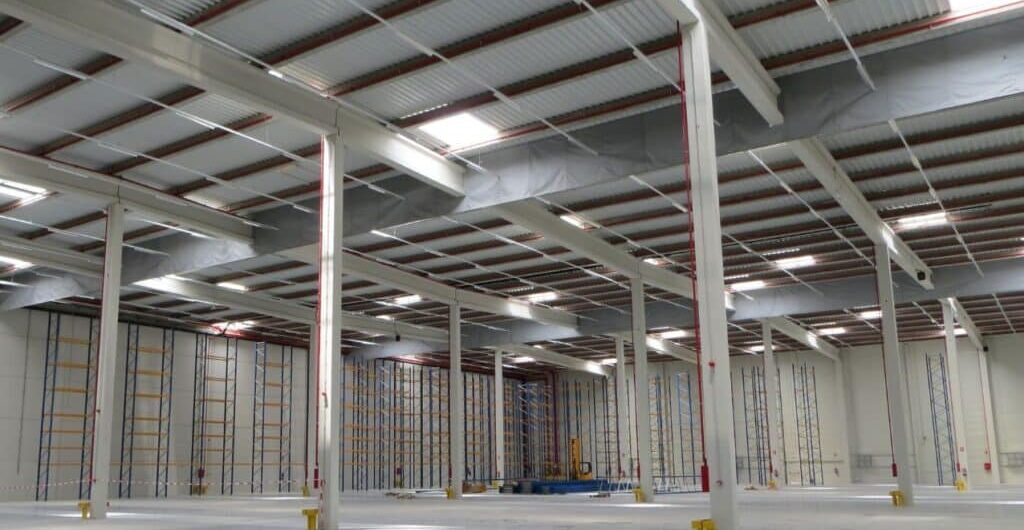
Smoke-control curtains and how they can be combined with automatic sprinkler systems
We have already discussed the standards regulating fire sectors. In the US, there are several NFPA standards governing fire curtains: 92, 204, 13 and 409.
However, these systems are usually part of a fire protection project that includes other systems, such as fire detectors or sprinklers.
But, in case of fire, smoke control curtains can be very useful when it comes to minimizing the damage caused by sprinkler systems. This is because they ensure proximity between the smoke and the fire, which means sprinklers can be activated more efficiently, and only when they are strictly necessary.
But what do the standards say about combining fire curtains and sprinklers? What about Early Suppression Fast Response (ESFR) sprinklers?
The possibility that fire curtains and sprinklers might hinder each other is usually dealt with in the same manner as when beams or other construction elements cause obstructions in gutters and drains. But Spanish standards (UNE EN 12845:2016 regulating automatic sprinklers) and international standards (NFPA 13) offer us some interesting criteria on how to combine them.
NFPA 13: Standard for the Installation of Sprinkler Systems
This American standard defines draft curtains as a continuous material that protrudes downwards from the ceiling to contain smoke and heat. A smoke and heat ventilation system that is regulated further in NFPA 204-2015.
Regarding their combined use with sprinklers, this standard emphasizes curtains where ESFR sprinklers are installed together with standard sprinklers.
IFC Section 5106.3.2, “Automatic Sprinkler Protection,” requires curtains to separate high-temperature and ordinary ceiling sprinkler systems. For these applications, the curtains are required to be of non-combustible manufacture, that is, made with materials such as fiberglass, used as a thermal insulation textile solution for fire curtains and smoke control barriers.
The standard also stipulates that it is only mandatory to combine these systems if this is required by local regulations, and special attention ought to be given to sprinkler obstructions or obstacles when installing sectorization systems.
How does the Spanish standard approach the issue? Reviewing UNE EN 12845:2016
In its Annex P, the UNE EN 12845:2016 standard addresses the interaction of smoke control curtains with ESFR (Early Suppression Fast Response) sprinklers, which are ceiling sprinklers that can suppress fires within storage risks.
The standard highlights the small margin of error that exists in the design and installation of ESFR sprinkler systems, whose design principles and operating characteristics are significantly different from standardized sprinkler protection.
Annex P.11.6, which discusses sprinkler placement relative to air or smoke curtains, explains that where air or smoke curtains are installed at ceiling level, forming openings, the air or smoke curtain shall be treated as a limit.
For its part, Annex P.11.7, which addresses the situation of ESFR sprinklers relating to air or smoke curtains, indicates that where fire protection authorities require air or smoke curtains within ESFR sprinkler networks, sprinklers on each side of the air or smoke curtain should be the same distance (± 200 mm) from the smoke curtain. It also points out that the distance of sprinklers from the air or smoke curtain could vary along the length of the air or smoke curtain if there are changes in sprinkler spacing.
Lastly, the standard, in its Annex P.11.8 on the protection of ESFR sprinklers adjacent to areas protected by standardized sprinklers, indicates that the following measure should be implemented:
In locations where adjacent ESFR and non-ESFR sprinklers are at the same ceiling height or where ESFR sprinklers are installed at a higher ceiling height than non-ESFR sprinklers, ceiling smoke curtains shall be installed separating the ESFR and non-ESFR sprinklers.
In addition, it indicates that smoke screens must be at least 600 mm deep and located midway between ESFR and non-ESFR sprinklers. Like the American standard, it adds that the smoke screen must be made of non-combustible material.
As we can see, the standards addressing how these systems should be combined are quite loose and they are more stringent as regards their application in industrial environments. However, structural interference in ceilings is sometimes utilized to install curtains, and, for this reason, it is essential to be familiar with the pertinent standards.
As the maximum distance between the sprinklers and the wall should not be greater than half the maximum distance between sprinklers, it is common to apply this equivalence to the obstructive elements.
As we have seen, it is very important to comply with the standards and apply the necessary calculations in those situations in which these are not very specific, as this will contribute to protecting buildings. Are you looking for help to protect your building against fires?
Contact us and we will offer you a solution tailored to your needs.